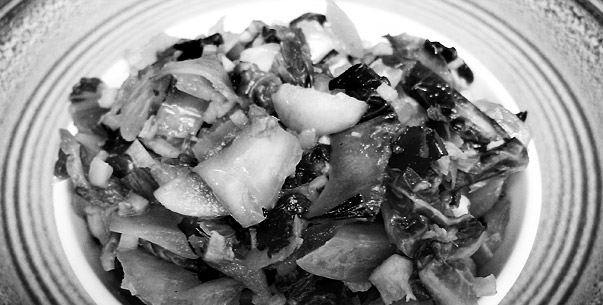|
|
 |
kuanyin's kitchen
autumn kimchi
restore your chi with this fermented favourite from Korea
|

photo by karen messer
I have always loved food and been an adventurous eater. In the late 1980s, I followed a macrobiotic diet and learned that live ferments have digestive benefits and healing qualities. But it wasn’t until I had a garden that I really understood the practical significance of these foods as a method of preservation and had a reason to start learning how to ferment food.
This recipe adapts the Korean style of fermenting vegetables, called kimchi. Like any vegetable ferment, it can be made with a wide variety of vegetables and in many different styles. This particular recipe uses vegetables that are abundant in the autumn harvest.
Cabbage and radish grow easily in temperate climates and are often the basis for Kimchi. Other vegetables add texture, colour and flavour. What distinguishes kimchi from sauerkraut is the use of spices. The kimchi quartet is garlic, ginger, hot pepper and onions (or leeks, scallions or shallots). These spices add flavour and have antimicrobial properties that protect the kimchi from surface moulds, narrowing the range of what can grow on the veggies. Salt helps in this way too, and also pulls juices out of the vegetables, adds flavour and makes the vegetables crunchier.
No ingredient in the recipe is absolutely necessary and it doesn’t require any special tools or cooking, just a few days to ferment. Substitute the ingredients and vary the proportions freely. But for a successful ferment, the vegetables must be submerged in liquid, not exposed to air.
For me, sharing food with people is a path of community service. I get huge satisfaction from making beautiful, alive food to nourish people, not only those I love but total strangers too. Live-culture foods can be dramatically transformative, and that is a source of great pleasure to me.
Autumn Kimchi
It is customary in Korea to eat kimchi with every meal, and there are infinite variations, depending upon the season, region and family tradition.
Makes 1 quart
Preparation time: approximately 15 minutes
Fermentation time: 1 week or more
Ingredients (for 1 quart)
1 lb. napa cabbage or bok choi, coarsely chopped
1 daikon radish or a few red radishes, sliced into half moons
2 carrots, sliced into half moons
2 green tomatoes or tomatillos, chopped
6 inches dulse or other seaweed, cut with scissors
1 onion or leek (and/or a few scallions/shallots), chopped
1 bulb garlic, peeled and chopped
3 or 4 hot peppers (or more, depending on how hot you like your food), chopped
3 tbsp. (or more) fresh grated gingerroot
1 tbsp. unrefined sea salt
Method
1. Mix the chopped vegetables with spices and salt in a bowl. Incorporate other vegetables if you wish, including turnips, okra, beans or peas, Jerusalem artichokes, eggplant, cauliflower or squash.
2. Stuff the kimchi mixture into a quart-size, wide-mouth jar. Pack it tightly into the jar, pressing down hard until the juices squeeze out from the vegetables. Mixed with the salt, these juices make a brine. The vegetables must be submerged in liquid to prevent mould from forming.
3. Place the lid on the jar but do not close.
4. Allow the mixture to sit for at least 1 week. Press the kimchi down each day so the vegetables at the top get submerged under the brine. The longer the kimchi ferments, the more sour it will become. When it tastes ripe, eat or store in the refrigerator.
Sandor Ellix Katz is a fermentation revivalist, activist and author, who travels widely teaching and sharing fermentation skills. Sandor is a long-term AIDS survivor and considers live-culture foods an important part of his healing. He lives at a queer intentional community in rural Tennessee. His books are Wild Fermentation: The Flavor, Nutrition, and Craft of Live-Culture Foods and The Revolution Will Not Be Microwaved: Inside America's Underground Food Movements. For more information, visit www.wildfermentation.com.
|